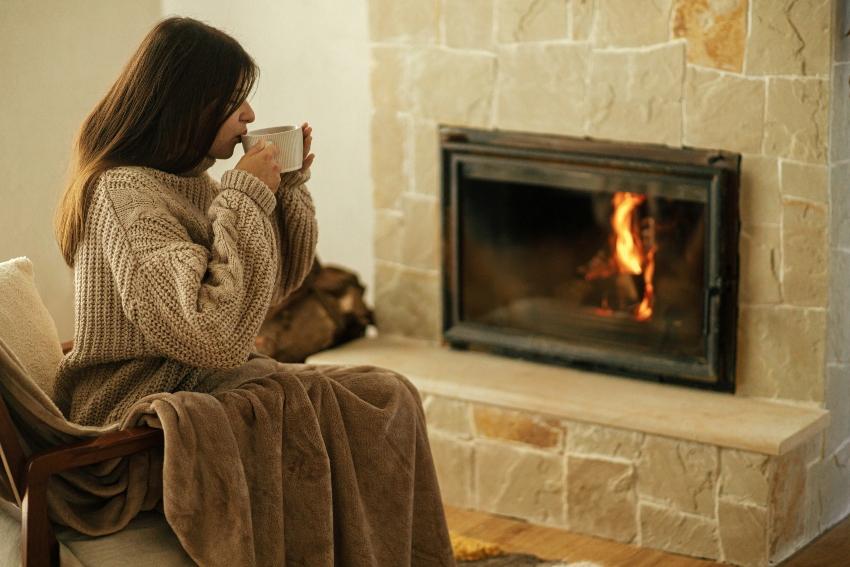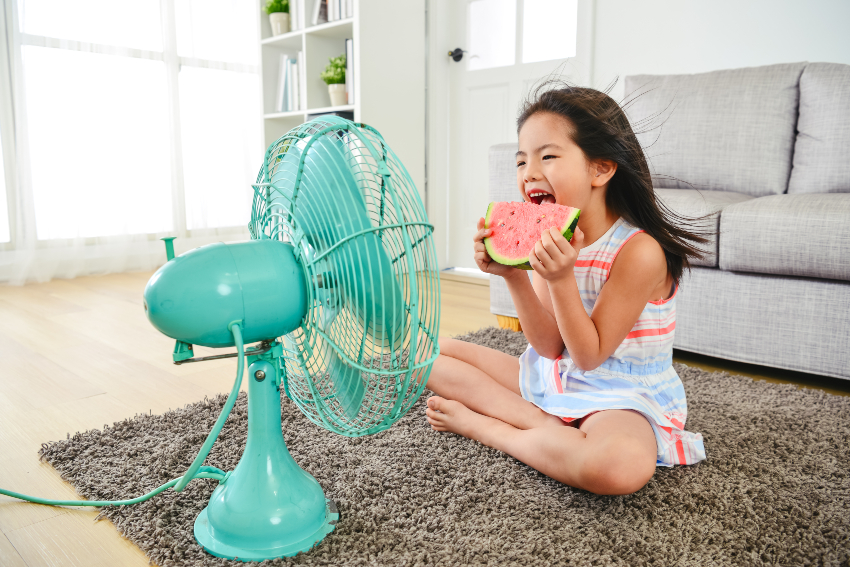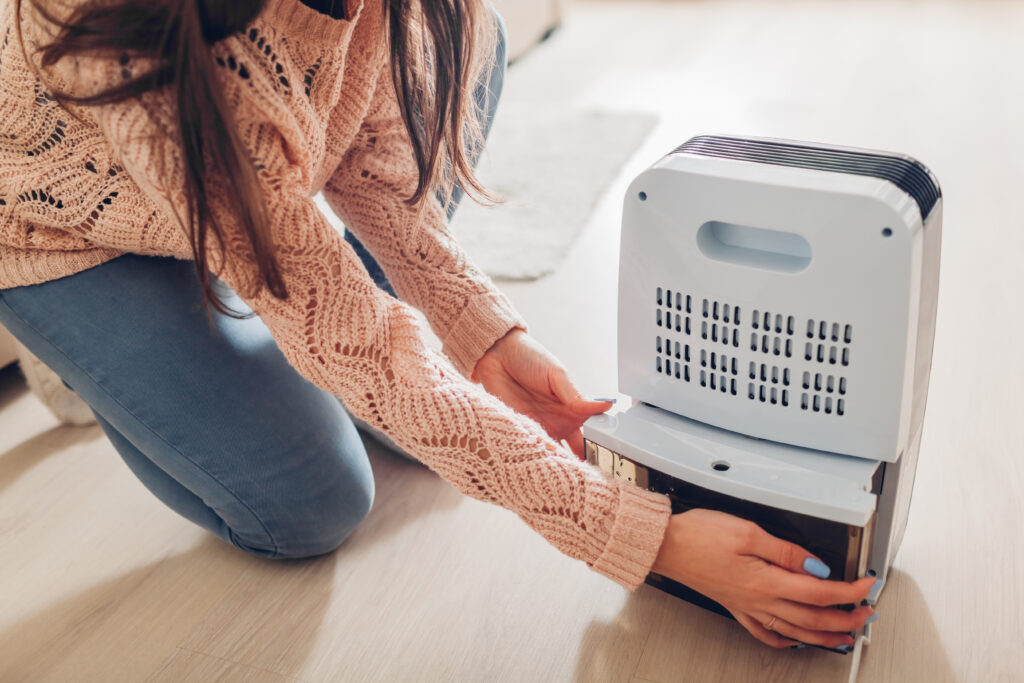Five Health Benefits of Using a Humidifier
Posted on by WestAIR Heating & Cooling

Winter brings dry air into our homes, and with it, a number of health issues. Many people suffer from dry skin, scratchy throats, and nosebleeds during the colder months. Fortunately, using a humidifier can remedy many of these ailments while also introducing several benefits. Keep reading to learn five health benefits of using a humidifier.
Prevent Skin from Drying Out
Both cold air from outside and hot air from your furnace will dry out your skin. This can make it itchy, flaky, and irritable. A humidifier will keep the moisture in the air at a healthy level, hydrating your skin. Moist air is especially important for people who suffer from conditions such as eczema. It can also keep lips from cracking and prevent hair from becoming dry and frizzy.
Keep Your Airways Healthy
Dry air also irritates your throat, nose, and even your vocal cords. Properly humidified air can soothe a dry, scratchy throat. If you are suffering from a cold or the flu, a humidifier can make your cough more productive, helping you expel phlegm and mucus more quickly. Moist air can also reduce snoring, which is a common symptom of dry airways.
Treat Sinus Congestion
Many people experience runny or stuffy noses during the winter. Did you know that a humidifier can help relieve sinus congestion? Installing a humidifier is one of your best defenses against sinus pressure and the resulting headaches.
Prevent Bloody Noses
Nosebleeds can range from a minor annoyance to a major inconvenience, depending on the situation. They can be especially embarrassing when you are in public and frustrating when you are trying to relax at home. Cold, dry air is perhaps the most common reason for nosebleeds, making a humidifier essential for anyone who is prone to them.
Reduce Germs in Your Home
Viruses and bacteria travel easier in cold, dry air, leading to the proliferation of the flu and other illnesses during the winter. In contrast, humid air can trap and neutralize viruses. This means that while a humidifier does not kill germs, it can hinder their spread. Research suggests that humidifiers are especially effective at slowing the spread of influenza. However, different bacteria and viruses may thrive in humid air. This is an emerging field of research, and more studies are needed to determine the relationship between humidity and viruses.
Order a Humidifier from WestAIR Heating & Cooling
There’s no need to suffer from dry skin, irritated throats, or bloody noses during the winter. WestAIR installs effective, low-maintenance humidifiers from trusted brands. Contact us today to discuss the best option for your home and take the first step toward eliminating the dry air from your home.
This entry was posted in Health Tips,Humidifier,Humidity and tagged Health tips, Humidifier, WestAIR Heating & Cooling
Local HVAC Services and Solutions for Total Indoor Air Comfort
Posted on by WestAIR Heating & Cooling

When it comes to weather, in Minnesota, we live in a state of extremes. That’s why we rely on our homes to provide an oasis of clean air and cozy temperatures all year long. And WestAIR Heating & Cooling has you covered. Read on to learn more about the HVAC services and solutions we offer as your local source for total indoor air comfort.
Home Heating Solutions
The snowy and bitterly cold winters make reliable, efficient heating systems vital to our comfort, health, and safety. WestAIR offers a full range of solutions, and our expert technicians will help you find the perfect fit for your home and provide professional installation.
- High-efficiency furnaces warm your entire home in the most cost-effective way, leading to lower energy bills. Additionally, qualifying systems allow you to claim a federal tax credit.
- Radiant floor heating provide heat from the ground up instead of via forced air through vents, which eliminates air loss in ductwork. This also means dust and allergens aren’t being blown into the home and decreasing air quality.
- Gas fireplaces allow you to add beauty as well as comfort. Our experienced technicians will help you choose the right model, style, and finishing touches to optimize performance and ultimately boost your home’s value.
- Unit/garage heaters let you use your garage for more than parking. By keeping the space warm, it can be used for year-round storage, social and recreational activities, hobbies, and more.
Home Cooling Solutions
While our air is extremely cold and dry, the summers are full of heat and humidity. But don’t worry—we provide the same level of experience and expertise when it comes to home cooling solutions.
- High-efficiency air conditioning (A/C) systems deliver cost-effective cooling while also helping maintain proper humidity levels. And just like the furnaces mentioned above, many will qualify you for a federal tax credit.
- Ductless mini-split A/C systems require no ductwork, making them ideal for homes/spaces where adding ducts is impractical or too expensive. They can also provide heating as well as cooling.
HVAC Efficiency and Indoor Air Quality Solutions
Indoor air quality (IAQ) affects comfort as well as overall health. Rely on WestAIR to help ensure the air inside your home is both clean and cozy.
- Air exchangers help remove stale, unhealthy indoor air while simultaneously providing fresh, pre-filtered outdoor air.
- Air cleaners do just what the name implies: They clean the air by trapping harmful airborne particles before they can pollute the home and be breathed in by you and your loved ones.
- Whole house humidifiers maintain relative humidity levels, helping avoid dry-air issues such as dry skin, cracking/warping of furniture and wood, and inefficient heating.
- Programmable/setback thermostats allow you to pre-set temperature and humidity settings for multiple days. This allows you to maintain cost-effective comfort without constantly having to adjust the thermostat.
- Automatic zoning systems separate your home into zones that can be individually controlled. That way, you don’t have to waste energy and money heating/cooling areas that are rarely used.
- Ultraviolet (UV) light air purification systems work in conjunction with your current HVAC to eliminate viruses, bacteria, mold, and other harmful airborne pathogens for improved IAQ.
HVAC Maintenance Services
As your local source for all things HVAC, WestAIR also provides a full range of professional maintenance services:
Your home should be a private escape from the extremes of Minnesota weather. We’re here to help make the best decision for you and your home, as well as ensure your systems run at peak performance and efficiency.
Contact WestAIR today to learn more about our HVAC services and solutions for total indoor air comfort.
This entry was posted in AC,Air Cleaners and Purifiers,Air Conditioning,Cooling,Duct Cleaning,Energy Savings,Furnace,Health Tips,Heating,Humidifier,Humidity,HVAC Maintenance,Indoor Air Quality,Repairs,Tips,Winter and tagged Furnace, Heating, Home Cooling Solutions, Home Heating Solutions, HVAC Services, HVAC Solutions, Indoor air quality, Service, Thermostat, Tips & advice, Total Indoor Air Comfort, WestAIR, WestAIR Heating & Cooling, WestAIR Services
IMPROVING YOUR INDOOR AIR QUALITY: DEHUMIDIFIERS
Posted on by WestAIR Heating & Cooling
During the summer months, do you find the air inside your home feeling damp? Living in Minnesota, we know exactly what an overly humid summer day feels like, even from inside. Not only is it sticky and uncomfortable, but we also see a rise in our electricity bill from our HVAC system working overtime. Humid air can also damage floors, furniture, and walls making homeowners spend even more money down the line. A dehumidifier can fix all of this. Read our blog as we discuss how dehumidifiers can improve your indoor air quality.
Why do you need a dehumidifier?
Dehumidifiers are the key to better air quality in your home. Not only do they help maintain your comfort, but also help prevent the growth of mold in your home, which means improved health and safety for you and your loved ones. When there is less humidity in the air, it also allows you to raise the temperature a few degrees to save on cooling expenses. Installing a dehumidifier is sure to save you money and benefit your health in the years to come. The gains of a dehumidifier are infinite!
How do dehumidifiers work?
Dehumidifiers work in one of two ways, either by refrigeration or absorption. Let’s take a look at how both methods work.
- Refrigeration: These dehumidifiers pull moisture over a cooling coil inside either a portable or whole house dehumidifier. The moist air condenses down, and any vapor is turned into droplets that collect in a pan or directly down a drain. Now free of moisture, the air passes over the hot compressor and warms back up to its original temperature before being blown back into the room.
- Absorption: These dehumidifiers pull moist air in through a duct which then moves past a large rotating wheel. The wheel is made of water-absorbing material. Once the air meets the wheel, any vapor is absorbed into the material leaving only dry air to be blown back out into the room.
Dehumidifier types and models
Dehumidifiers are available in a variety of different models. If you are looking to dehumidify a small space, a portable dehumidifier is the way to go. Portable models are available in different sizes, yet they all function the same by collecting moisture in a container. Whole house dehumidifiers are similar, but they empty directly into a drain.
If you are looking to dehumidify your whole home, you can purchase a system that attaches to your HVAC system. Living in Minnesota, this is a staple for living comfortably. Excessive humidity can seep into your home decreasing the indoor air quality and becoming a breeding ground for mold growth. HVAC dehumidifier attachments allow your cooling system to work efficiently and keep your home’s air quality and moisture level at your desired level.
The professionals at WestAIR are ready to assist with all your home comfort needs. Contact WestAIR Heating and Cooling today to learn more about reducing humidity and improving your indoor air quality.
This entry was posted in Cooling,Humidity,Indoor Air Quality and tagged Dehumidifier, Heating and cooling, HVAC, Indoor air, Indoor air quality, WestAIR
Keeping Air Ducts Clean
Posted on by WestAIR Heating & Cooling

In a previous blog, we discussed air duct cleaning and maintenance. Because these duties help provide better indoor air quality, we wanted to mention them again and reiterate their importance to your home and health. Learn more about some reasons for keeping air ducts clean and ways to do so.
Indoor Air
Wherever you go, it only makes sense that you want to breathe the cleanest, healthiest air possible.
The Environmental Protection Agency estimates that the average American spends 90 percent of their life indoors. As such, it’s important for your home’s air to be free of as many contaminants as possible. This is especially important since the accumulation of indoor air pollutants is exponentially higher than regular outdoor concentrations.
Some effects of poor indoor air include respiratory issues and disease, headaches, dizziness, and fatigue. Oftentimes indoor air pollutants can increase the intensity of issues like asthma and even cause eye, nose, or throat dryness and irritation. Protect yourself and your family by keeping air ducts and your home’s air clean.
Duct, Duct, Dirty Duct?
Your HVAC system often pulls in outside air to condition and distribute through the home, so dirt, dust, and other allergens find their way in. Since the ductwork throughout your home is hidden, you probably don’t give it much thought. And because it’s hidden, it’s more difficult to access and clean.
So how do you know if your ductwork is hiding something unhealthy? Look for telltale signs, such as:
- Dust. If you continually notice dust even after you’ve cleaned, check your vents. Remove the register cover to see if the ductwork is lined with dirt or dust, too.
- Cost increase. Are your utility bills noticeably higher compared to the same time last year? Your HVAC system may be working harder (and less efficiently) because of restricted airflow. This could be from dirty ducts or dirty air filters. A trusted technician can perform an inspection and determine the cause.
Keeping Air Ducts Cleaner
Routine home maintenance can help keep your air ducts cleaner and your indoor air fresher.
Check and change HVAC filters. This could be every 30 days or every few months, depending on how often your system runs, if you have pets, or if you have younger children or allergy sufferers in the home. Check the filter on a regular basis and change it as needed.
Have your HVAC system inspected at least once a year to ensure it is operating at peak performance. This will also allow you to catch and fix any smaller issues before they become potentially bigger problems. Routine maintenance can extend the life of your heating and cooling systems, saving you money in the long run.
Complete household chores each week. This includes dusting hard surfaces and flooring, vacuuming carpeted areas (and vent covers), and running bedding through the wash. Also, vacuum and wash pet bedding as needed, and consider a high-quality HEPA filter vacuum to further reduce indoor air contaminants.
A few upgrades will also go a long way toward improving air quality at home.
- Rid your home of dry air with a whole house humidifier. Dry air can make skin to feel tight and itchy or cause nose or throat discomfort. The wood inside your home can also be negatively affected by dryness. Adding moisture to the air can increase your overall home comfort.
- Remove odors and pollutants with a UV light air purification system. A BreatheCLEAN UV air purifier works with your current HVAC system and removes contaminants to provide continuous protection.
Small changes to daily, weekly, and yearly routines can help with keeping air ducts clean while increasing overall indoor air quality. If you think your ductwork should be checked, rely on the experienced professionals at WestAIR Heating & Cooling.
Contact us today to learn more about our duct cleaning or other services.
This entry was posted in Duct Cleaning,Health Tips,Humidifier,Humidity,HVAC Maintenance,Indoor Air Quality,Spring,Tips and tagged Air ducts, Clean Air Ducts, Duct cleaning, Duct Cleaning and Indoor Air Quality, Duct cleaning service, HVAC Maintenance, HVAC System Efficiency, Keeping Air Ducts Clean, Professional duct cleaning, Residential HVAC, Signs of Dirty Ductwork, westair heating and cooling
7 Tips for Extending the Lifespan of HVAC Equipment
Posted on by WestAIR Heating & Cooling

When it comes to weather, Minnesota is a place of extremes. Our harsh, bitterly cold winters and hot, humid summer days make a functioning furnace and air conditioner crucial to a comfy home. Follow these tips for extending the lifespan of HVAC equipment to get the most out of your system.
Schedule Preventative Maintenance Twice Annually
Have your system professionally serviced before each heating and cooling season for a thorough tune-up, cleaning, and maintenance service to ensure peak performance and efficiency. Your technician will also catch minor issues to prevent costly repairs later on, as well as help you decide if it’s better to repair or replace.
But don’t wait for maintenance service or a total breakdown to have your system inspected. If you notice strange sounds or smells, decreased efficiency or performance, or any other warning signs, call your local HVAC professionals to diagnose and repair the issue before it gets worse.
Have Ductwork Professionally Cleaned Every Other Year
Dirt, dust, pollen, and other debris naturally settle inside your ductwork over time. This buildup not only impacts airflow and efficiency, but it also becomes a breeding ground for bacteria. As your HVAC unit pumps air to the home, these contaminants get blown out with it and decrease your indoor air quality.
Schedule professional duct cleaning service once every two years to help maintain air quality and reduce stress placed on the system.
Maintain a Clean Air Filter
Clogged filters decrease airflow, forcing the system to work harder and experience a higher level of wear and tear. They’re also the number one cause of breakdowns. Remember to clean or change your HVAC system’s air filter every month.
Take Care of the Condenser Unit
While A/C condenser units are designed to withstand the elements, they’re not invincible. Inspect your condenser for any damage or debris buildup on occasion, especially after severe storms and instances of hail. Additionally, give the unit two to three feet of space to easily and efficiently draw in air. Keep the unit and surrounding space clean and clear of obstructions as well as grass clippings, leaves, branches, dirt, and other debris.
Check the Drainage Pipe Regularly
HVAC systems feature a PVC pipe on the indoor unit that leads outside to drain excess condensation. Serious damage to this outlet line can result in expensive repairs, so inspect yours regularly for blockages, debris, and any other issues. Be sure to do so more frequently in winter due to the potential of ice or snow deposits.
Invest in a Programmable Thermostat
Being strategic with your thermostat can help lower utility bills and stress on your system. However, constantly adjusting the temperature can have the opposite effect. With a programmable thermostat, you can preset temperature and humidity levels over multiple days without worrying about manual adjustments.
Ease Stress on the System in Other Ways
Give your HVAC system a break whenever possible to maximize its performance and useful life. For more information, check out our helpful guides to optimizing HVAC efficiency in the winter and summer.
Heating and cooling systems contribute up to half of a home’s energy consumption, and we rely on them throughout the year in our state. Use this guide to extending the lifespan of HVAC equipment to keep the air in your home clean and comfy for years to come.
Backed by over 30 years of industry experience, locally owned and operated WestAIR has the knowledge and expertise for all your heating, cooling, and indoor air quality needs. Contact us to learn more about our services.
This entry was posted in AC,Air Conditioning,Cooling,Duct Cleaning,Energy Savings,Fall,Furnace,Health Tips,Heating,Humidity,HVAC Maintenance,Indoor Air Quality,Tips,Winter and tagged A/C, A/C maintenance, A/C Tips, Air conditioner maintenance, Air filters, Condenser Unit Maintenance, Duct cleaning, Energy savings, Energy-Saving HVAC Tips, Extending the Lifespan of HVAC Equipment, Furnace Maintenance, Furnace Tips, Homeowner Education, HVAC Education, HVAC Maintenance, HVAC Maintenance Tips, HVAC tips, Preventative Maintenance, Programmable thermostat
7 Tips for Winter Indoor Air Quality Maintenance
Posted on by WestAIR Heating & Cooling

With the recent snowfall and chilly temps, there’s no denying that winter is almost here. Time to prepare! As heating season makes its way to Minnesota, we must remember to keep the air in our home clean as well as warm. Use this guide to winter indoor air quality maintenance to keep your family cozy, healthy, and happy throughout the season.
Poor Winter Indoor Air Quality: Causes and Effects
When cold weather hits, we seal our homes to prevent the warm air produced by our furnaces from escaping. While this helps increase comfort and energy efficiency, it also traps dust, pollen, and other airborne contaminants inside the home that then decrease indoor air quality. Common signs of poor winter indoor air quality include:
- Dry, itchy, or watery eyes
- Cold or flu symptoms: coughing, sneezing, nausea
- Heightened symptoms of asthma and other respiratory illness
- Fatigue and trouble concentrating
- Irritation of the nose and throat, particularly dryness
- Headaches
Tips for Winter Indoor Air Quality Maintenance
Escaping the bitter cold of Minnesota winters means spending more time inside our home, making clean indoor air crucial to our comfort and health. Thankfully, homeowners can improve and maintain air quality with these helpful tips.
- Clean regularly – Don’t let dust, mold spores, and other pollutants build up around the home. Dust hard surfaces and vacuum (using a vacuum with a HEPA filter if possible) at least weekly. Use non-toxic cleaners free of volatile organic compounds (VOCs), which are a major contributor to unhealthy air.
- Maintain a clean filter – Air filters keep dust and other debris from entering and harming your HVAC system, but must be maintained in order to prevent these irritants from making their way back into the air. Remember to change air filters monthly or clean if resuable.
- Schedule annual service maintenance – Ensure your heating system runs at peak performance and provides clean, warm air with professional maintenance service from a WestAIR HVAC expert.
- Have your ductwork cleaned – Dirt, dust, pet hair and dander, and other irritants settle inside your air ducts over time. Schedule duct cleaning service before winter is in full swing, and plan to do so annually.
- Enhance ventilation with an air exchanger – Sealing the home in winter leads to recycled, stale air inside. To resolve this, air exchangers deliver a continuous flow of fresh, filtered outdoor air while simultaneously exhausting unhealthy indoor air.
- Control humidity with a whole house humidifier – Humidity plays a crucial role for indoor air quality. Dry winter air can cause nose, throat, and skin discomfort, as well as damage wood fixtures and furniture over time. Installing a whole house humidifier will help maintain proper humidity levels in your home.
- Consider additional clean air solutions – Air cleaners work with your current system to remove excess dust and other irritants that decrease indoor air quality. Ultraviolet (UV) light purification systems utilize UV rays to eliminate odors harmful airborne pathogens like viruses, bacteria, mold, and VOCs.
This year has presented us all with new and unique challenges. But no matter how unpredictable 2020 has been, we know we can always plan for harsh winter weather here in Minnesota. We’re already seeing the temps drop and snow fall, so don’t wait! Use these winter indoor air quality maintenance tips to enjoy clean, comfy air inside your home this heating season.
For all your heating and cooling needs, trust the HVAC experts at WestAIR. Contact us today to learn more.
This entry was posted in Duct Cleaning,Furnace,Health Tips,Heating,Humidifier,Humidity,HVAC Maintenance,Indoor Air Quality,Tips,Winter and tagged Air cleaner, Air exchanger, Duct cleaning, Duct cleaning service, Heating, Heating Tips, Humidfier, Humidity, Humidity Management, HVAC tips, Indoor air quality, Indoor air quality solutions, Professional duct cleaning, Residential HVAC, Ventilation, WestAIR Heating & Cooling, Winter, Winter HVAC, Winter HVAC Tips, Winter Indoor Air Quality, Winter Indoor Air Quality Maintenance, Winter Tips, Winterize
Get a Handle on Home Humidity
Posted on by WestAIR Heating & Cooling

Around this time last year, we wrote about surprising ways to reduce humidity in your home. We hope some of those tips proved helpful. With the recent summer rain, heat, and excess moisture, we thought now would be an ideal time to revisit the issue to help you get a handle on home humidity.
Humidity levels
Humidity is the amount of moisture in the air around you. During the summer, humidity levels in your home should measure between 30-50 percent. Humidity levels that are too high or too low can lead to issues with your comfort, health, and home.
Too much humidity prevents the body from regulating its internal temperature, making you and your family feel sticky and uncomfortable. Excess moisture also promotes mold, fungus, and dust mites, which can wreak havoc on allergies and make you sick. Over time, dampness within the home can warp floorboards or furniture and cause wood to rot, resulting in costly repairs.
Conversely, too little humidity causes skin to feel itchy and can dry out the body’s mucous membranes, leading to sore throats, coughing, and nosebleeds. Dryness affects your home, too, when door frames or other features or furnishings made from wood begin to crack, shrink, or bend.
Poor humidity? Here’s how to tell
Establishing a comfortable home environment relies on finding an appropriate balance of air moisture. How do you know if your home humidity levels are out of whack? Look for indicators such as:
- Condensation. Water beads are visible on the inside of the windows.
- Constant sweating. You experience persistent perspiration, even after taking a cool shower.
- Musty smells. You may not be able to see mold and mildew, but you can smell it.
- Difficulty sleeping. Excess moisture makes the body work harder to cool itself, which can be a challenge when you’re trying to fall or stay asleep.
- Water spots. Watch for stains on the walls, ceilings, or basement floor, especially after or during a rain shower.
- Trouble breathing. High humidity can trigger allergies and asthma symptoms.
Regulating home humidity
Summer is sticking around for a bit longer, so make sure you’re enjoying the tail end of the season by staying cool and dry at home. Here are some reminders for keeping home humidity levels low.
- Use exhaust and ventilation fans in the kitchen and bathroom. Leave those fans on for a short while after you’ve finished cooking or showering to ventilate humid air.
- Take advantage of your air conditioner. Your A/C unit brings in cooler air while expelling warmer, humid air.
- Take shorter, cooler showers. The less hot water you use, the less steam and humidity build up in the air.
- Check your gutters. Keep them free from debris to avoid water buildup and indoor leaks. Also, be sure the downspout is positioned away from your home.
- Consider investing in a dehumidifier. These portable appliances or whole home systems can help remove moisture from the air.
The experts at WestAIR Heating & Cooling are here to discuss your home humidity concerns and needs. Our technicians can explain how our high-efficiency air conditioners or air quality accessories can help you stay cool and achieve optimum indoor air quality throughout the summer. Contact us today to schedule service.
This entry was posted in Cooling,Humidity,Indoor Air Quality and tagged Air conditioner, Air quality, Air quality accessories, Humidity, humidity levels, Indoor humidity, regulating humidity
Subscribe to Our Blog
With RSS feeds, you don't have to visit our site everyday to keep up to date. Simply subscribe to our blog via RSS or Email and our posts will come to you!
Search Blog Posts
Categories
Archives
- April 2024 (1)
- February 2024 (1)
- January 2024 (1)
- February 2023 (1)
- January 2023 (1)
- December 2022 (1)
- November 2022 (1)
- October 2022 (1)
- September 2022 (1)
- August 2022 (1)
- July 2022 (1)
- June 2022 (1)
- May 2022 (1)
- April 2022 (1)
- March 2022 (1)
- February 2022 (2)
- December 2021 (1)
- November 2021 (1)
- October 2021 (1)
- September 2021 (1)
- August 2021 (1)
- July 2021 (1)
- June 2021 (1)
- May 2021 (1)
- April 2021 (1)
- March 2021 (2)
- January 2021 (1)
- December 2020 (1)
- November 2020 (1)
- October 2020 (1)
- September 2020 (1)
- August 2020 (1)
- July 2020 (1)
- June 2020 (1)
- May 2020 (1)
- April 2020 (1)
- March 2020 (1)
- February 2020 (2)
- November 2019 (1)
- August 2019 (2)
- June 2019 (1)
- May 2019 (1)
- April 2019 (1)
- March 2019 (1)
- February 2019 (1)
- January 2019 (1)
- December 2018 (1)
- November 2018 (1)
- October 2018 (1)
- September 2018 (1)
- August 2018 (2)
- July 2018 (1)
- May 2018 (1)
- April 2018 (1)
- March 2018 (1)
- February 2018 (1)
- January 2018 (1)
- December 2017 (3)
- November 2017 (2)
- October 2017 (2)
- September 2017 (2)
- August 2017 (1)
- July 2017 (2)
- June 2017 (3)
- May 2017 (2)
- January 2017 (4)
- November 2016 (1)
- September 2016 (3)
- July 2016 (2)
- June 2016 (2)
- May 2016 (4)
- April 2016 (1)
- March 2016 (2)
- February 2016 (2)
- January 2016 (1)
- August 2015 (1)
- July 2015 (1)
- June 2015 (3)
- May 2015 (1)
- July 2014 (2)
- June 2014 (1)
- April 2014 (1)
- March 2014 (1)
- February 2014 (2)
- October 2013 (1)
- May 2013 (1)
- March 2013 (1)
- February 2013 (1)
- August 2012 (1)
- July 2012 (2)
- June 2012 (2)
- May 2012 (2)
- March 2012 (1)
- February 2012 (1)
- December 2011 (1)
- November 2011 (1)
- October 2011 (1)
- September 2011 (1)
- August 2011 (1)
- June 2011 (1)
- May 2011 (1)

 Subscribe
Subscribe Subscribe
Subscribe